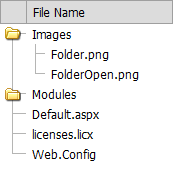How to: Display the File/Folder Tree (Virtual Mode)
- 2 minutes to read
In this example, the ASPxTreeList uses the Virtual data binding method to display the file/folder tree. In this mode, a tree is created on demand.
The image below shows the result.

using System.IO;
using System.Collections.Generic;
using DevExpress.Web.ASPxTreeList;
protected void ASPxTreeList1_VirtualModeCreateChildren(object sender,
TreeListVirtualModeCreateChildrenEventArgs e) {
string path = e.NodeObject == null ? Page.MapPath("~/") : e.NodeObject.ToString();
List<string> children = new List<string>();
if (Directory.Exists(path)) {
foreach (string name in Directory.GetDirectories(path)) {
if (!IsSystemName(name))
children.Add(name);
}
foreach (string name in Directory.GetFiles(path))
if (!IsSystemName(name))
children.Add(name);
}
e.Children = children;
}
protected void ASPxTreeList1_VirtualModeNodeCreating(object sender,
TreeListVirtualModeNodeCreatingEventArgs e) {
string path = e.NodeObject.ToString();
e.NodeKeyValue = GetNodeGuid(path);
e.IsLeaf = !Directory.Exists(path);
e.SetNodeValue("FileName", PopFileName(path));
}
// Helpers
Guid GetNodeGuid(string path) {
if (!Map.ContainsKey(path))
Map[path] = Guid.NewGuid();
return Map[path];
}
Dictionary<string, Guid> Map {
get {
const string key = "DX_PATH_GUID_MAP";
if (Session[key] == null)
Session[key] = new Dictionary<string, Guid>();
return Session[key] as Dictionary<string, Guid>;
}
}
string PopFileName(string path) {
return path.Substring(1 + path.LastIndexOf("\\"));
}
bool IsSystemName(string name) {
name = PopFileName(name).ToLower();
return name.StartsWith("app_") || name == "bin"
|| name.EndsWith(".aspx.cs") || name.EndsWith(".aspx.vb");
}